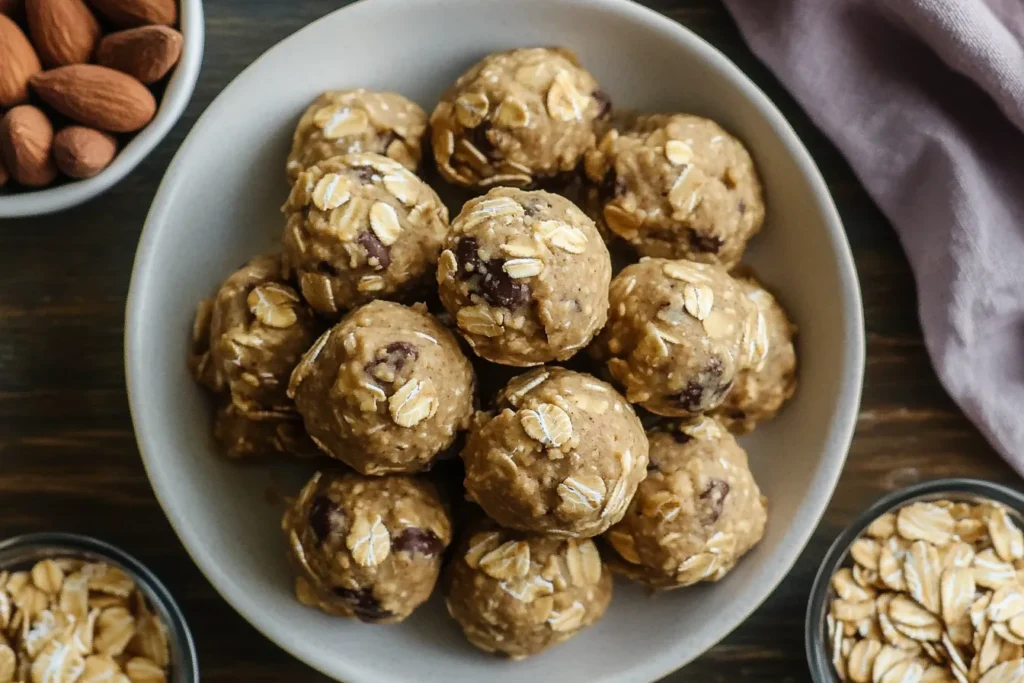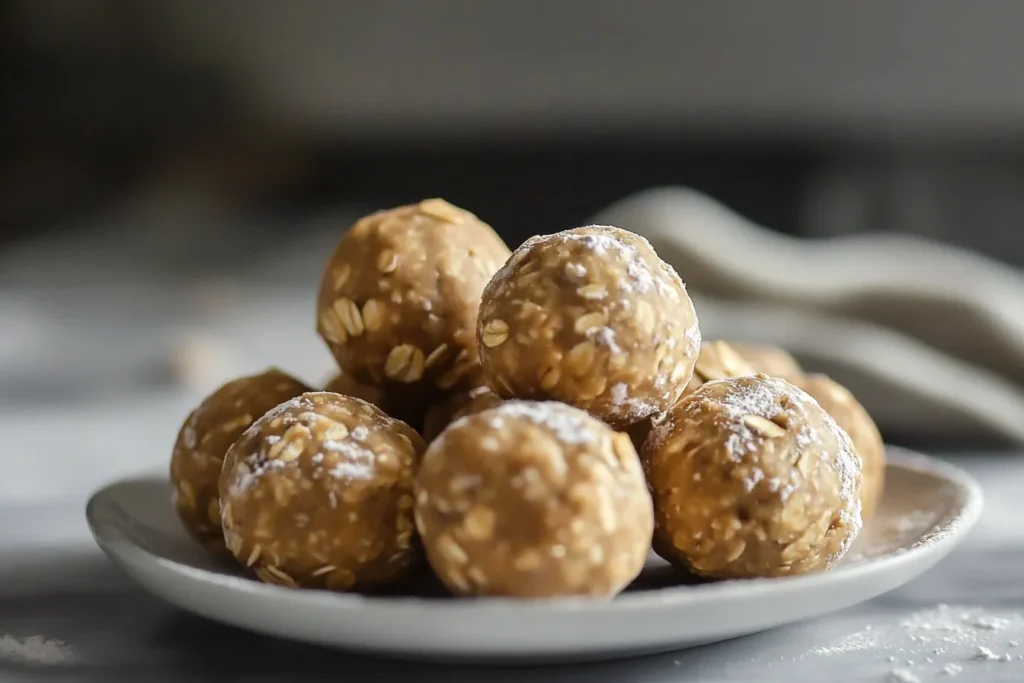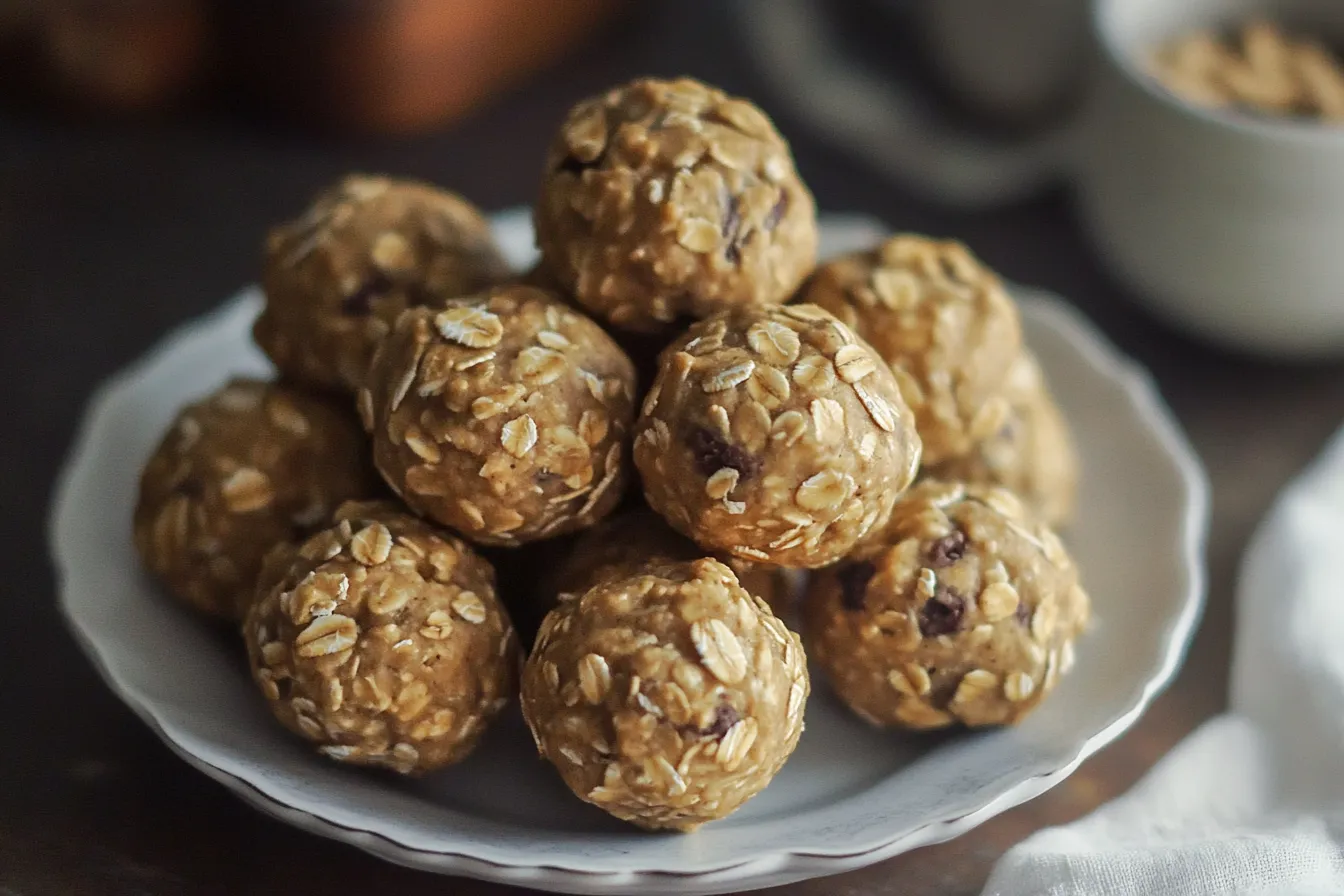Start your day with oatmeal and peanut butter, a delicious and nutrient-packed combo that helps stabilize blood sugar levels and keeps you energized. Wondering what the healthiest toppings are to elevate your oatmeal even further? Let’s dive in and explore!
The Science Behind Oatmeal and Peanut Butter
Oatmeal is high in carbohydrates, which can raise concerns about its potential to spike blood sugar. However, its fiber content, especially beta-glucan, plays a significant role in stabilizing blood sugar levels. Peanut butter, on the other hand, is packed with healthy fats and protein, which can slow digestion and reduce carbohydrate absorption, potentially mitigating blood sugar spikes. Check out more recipes here.
What Is Blood Sugar and How Does It Work?
Blood sugar, or glucose, is the body’s primary energy source. It is derived from the food we consume, particularly carbohydrates, and travels through the bloodstream to fuel cells. Insulin, a hormone, regulates blood sugar by helping cells absorb glucose, maintaining a balance.
When carbohydrates are consumed, they break down into glucose. Rapid digestion of certain carbohydrates can lead to blood sugar spikes, while slower digestion results in a steadier glucose release. Sustained high blood sugar levels can lead to insulin resistance and other health complications.
Nutritional Profile of Oatmeal: Fiber, Carbs, and Glycemic Index

Oatmeal is rich in complex carbohydrates, which digest more slowly than simple carbohydrates. Its nutritional benefits include:
- Fiber: Soluble fiber like beta-glucan slows digestion and aids in stabilizing blood sugar.
- Low Glycemic Index (GI): Oatmeal has a low GI, meaning it causes a gradual increase in blood sugar.
- Micronutrients: Oatmeal is a good source of magnesium, phosphorus, and zinc, which contribute to metabolic health.
Different types of oatmeal, including steel-cut, rolled, and instant, vary in their effects on blood sugar due to differences in processing and fiber content.
The Role of Peanut Butter in Nutrition: Healthy Fats and Protein
Peanut butter is an excellent addition to meals for blood sugar management. Its nutritional highlights include:
- Healthy Fats: Monounsaturated and polyunsaturated fats promote heart health and slow digestion.
- Protein: Supports sustained energy and balances carbohydrate intake.
- Micronutrients: Magnesium and vitamin E are beneficial for blood sugar regulation.
When combined with oatmeal, peanut butter helps create a balanced meal with reduced blood sugar impact.
Understanding Glycemic Index (GI) and Glycemic Load (GL)
The Glycemic Index ranks foods based on how quickly they raise blood sugar levels on a scale from 0 to 100:
- Low GI: 55 or below
- Medium GI: 56 to 69
- High GI: 70 or above
Glycemic Load (GL) considers the portion size of the food, providing a more practical measure of its effect on blood sugar. Oatmeal with peanut butter typically has a low GI and GL, making it a smart choice for blood sugar management.
How Different Types of Oatmeal Affect Blood Sugar
Not all oatmeal is equal in its impact on blood sugar:
- Steel-Cut Oats: The least processed, highest in fiber, and lowest GI.
- Rolled Oats: Moderately processed with a slightly higher GI.
- Instant Oats: Highly processed and fastest to digest, leading to quicker blood sugar spikes.
Choosing the right type of oatmeal is essential for maintaining blood sugar stability.
Why Fiber in Oatmeal Matters for Blood Sugar Stability
Fiber is a key component in blood sugar management. Soluble fiber slows the digestion of carbohydrates, ensuring a steady release of glucose into the bloodstream. This helps prevent sharp blood sugar spikes that can occur after eating refined carbohydrates.
A typical serving of steel-cut oats provides around 4 grams of fiber, making it a great option for stable blood sugar levels. Check out more recipes here.
Peanut Butter’s Role in Slowing Down Carbohydrate Digestion
Adding peanut butter to oatmeal introduces healthy fats and protein, which help delay gastric emptying. This slows the absorption of glucose into the bloodstream, leading to a steady energy release. Peanut butter’s low GI complements the high fiber content in oatmeal, making the combination a winning choice for those managing blood sugar.
Common Myths About Oatmeal and Blood Sugar Spikes
Several myths persist regarding oatmeal and its effects on blood sugar:
- All oatmeal causes blood sugar spikes.
Fact: The type of oatmeal and preparation methods significantly influence its impact. Steel-cut oats, for example, have minimal effects on blood sugar when compared to instant oats. - Peanut butter neutralizes all carbohydrates.
Fact: While peanut butter slows carbohydrate digestion, it does not eliminate the effects of carbohydrates entirely. - Sweeteners make oatmeal inherently unhealthy.
Fact: Natural sweeteners like honey can be used in moderation and balanced with fiber and protein.
The Role of Portion Sizes in Blood Sugar Control
Portion sizes play a crucial role in managing blood sugar levels. A standard serving of oatmeal is about half a cup of dry oats, providing around 150 calories and 27 grams of carbohydrates. Adding one to two tablespoons of peanut butter contributes approximately 190 calories and 7 grams of protein.
Eating large portions, even of healthy foods, can lead to elevated blood sugar levels. Practicing portion control ensures that meals remain balanced and blood sugar-friendly.
Can Oatmeal Alone Spike Blood Sugar?
Oatmeal, despite being a healthy choice, has the potential to cause blood sugar spikes when consumed alone. This is primarily because it is a source of carbohydrates, which are broken down into glucose during digestion. However, the extent of this spike depends on factors like the type of oatmeal and how it is prepared.
Steel-cut and rolled oats are digested more slowly due to their high fiber content, resulting in a gradual release of glucose into the bloodstream. In contrast, instant oats are processed to cook quickly, which also speeds up digestion, leading to a sharper rise in blood sugar levels. Pairing oatmeal with low-GI foods like peanut butter can mitigate this effect. Check out more recipes here.
How Adding Peanut Butter Changes the Glycemic Response

Peanut butter, with its combination of healthy fats, protein, and minimal carbohydrates, can significantly alter oatmeal’s glycemic response. By slowing the digestion of carbohydrates, peanut butter helps to:
- Reduce the speed at which glucose enters the bloodstream.
- Prevent sudden blood sugar spikes.
- Provide longer-lasting energy.
A tablespoon or two of natural peanut butter added to oatmeal can create a balanced meal that stabilizes blood sugar levels and keeps you feeling full longer.
Individual Responses to Oatmeal and Peanut Butter: Factors to Consider
Blood sugar responses can vary significantly between individuals due to factors such as:
- Insulin sensitivity: Those with better insulin sensitivity may experience a smaller spike in blood sugar.
- Activity levels: Physical activity helps muscles absorb glucose, reducing blood sugar spikes.
- Meal timing: Eating oatmeal and peanut butter at breakfast may have a different impact than consuming it later in the day.
- Overall diet: A diet rich in whole foods and low in processed sugars supports better blood sugar regulation.
Monitoring your own blood sugar response can help determine how oatmeal and peanut butter affect you personally.
Insulin Sensitivity and Oatmeal: What People with Diabetes Should Know
For individuals with diabetes, managing blood sugar levels is critical. Oatmeal and peanut butter can be a diabetes-friendly meal if prepared thoughtfully:
- Choose steel-cut or rolled oats for their low glycemic index.
- Add unsweetened peanut butter for its stabilizing effects.
- Avoid adding refined sugars or sweetened toppings.
Combining these foods with regular physical activity and consistent meal timing can further improve blood sugar control.
Does Timing of Consumption Affect Blood Sugar Levels?
The time of day when oatmeal and peanut butter are consumed can influence their effect on blood sugar levels. For instance:
- Breakfast: Eating oatmeal and peanut butter in the morning provides sustained energy and supports stable blood sugar levels throughout the day.
- Pre- or post-workout: Consuming this combination before exercise offers a steady energy source, while eating it afterward helps replenish glycogen stores without spiking blood sugar.
Timing meals to align with your body’s natural rhythms and activity levels can optimize blood sugar regulation. Check out more recipes here.
How Exercise and Activity After Eating Impact Blood Sugar Levels
Physical activity after a meal can significantly lower blood sugar levels by increasing glucose uptake in muscles. Even light activity, such as walking for 15–30 minutes after eating oatmeal and peanut butter, can:
- Reduce post-meal blood sugar spikes.
- Improve insulin sensitivity.
- Support long-term blood sugar management.
Combining a balanced meal like oatmeal with peanut butter and post-meal activity is an effective strategy for maintaining stable blood sugar levels.
Tips for Preparing Blood Sugar-Friendly Oatmeal with Peanut Butter
Creating oatmeal with peanut butter that supports stable blood sugar levels involves thoughtful preparation. Here are some tips:
- Choose Steel-Cut or Rolled Oats: These varieties have a lower glycemic index compared to instant oats.
- Add Natural Peanut Butter: Opt for unsweetened varieties with minimal ingredients.
- Control Portions: Stick to about ½ cup of dry oats and 1–2 tablespoons of peanut butter.
- Incorporate Toppings: Add chia seeds, flaxseeds, or a handful of nuts for extra fiber and healthy fats.
- Limit Sweeteners: If needed, use natural sweeteners like a small drizzle of honey or fresh fruit.
By balancing your oatmeal bowl with nutrient-dense ingredients, you can minimize blood sugar spikes and enjoy sustained energy.
Choosing the Best Oatmeal: What to Look For on Labels
When shopping for oatmeal, it’s important to focus on the nutritional details to ensure it’s blood sugar-friendly. Key things to look for include:
- Ingredients List: Choose oatmeal with no added sugars or artificial flavors.
- Fiber Content: Opt for oatmeal that provides at least 4 grams of fiber per serving.
- Processing Level: Steel-cut oats are the least processed and have the lowest glycemic impact.
- Avoid Instant Oats: These often have added sugar and a higher glycemic index.
Reading labels carefully can help you make informed decisions and select the best oatmeal for blood sugar control. Check out more recipes here.
Selecting the Healthiest Peanut Butter for Stabilizing Blood Sugar
Peanut butter’s quality can significantly impact its blood sugar benefits. Here’s how to select the healthiest option:
- Natural Varieties: Look for peanut butter made from only peanuts and a small amount of salt.
- Avoid Added Sugars: Check the label to ensure there are no added sugars or syrups.
- Skip Hydrogenated Oils: These are often found in processed peanut butter and can be harmful to health.
- Organic Options: Consider organic peanut butter for a cleaner, more natural product.
A high-quality peanut butter enhances the nutritional value of your oatmeal while keeping blood sugar levels steady.
Enhancing the Blood Sugar Benefits: Adding Ingredients Like Chia or Flax Seeds
Adding superfoods like chia seeds or flaxseeds to your oatmeal can amplify its blood sugar benefits. These ingredients are rich in:
- Fiber: Both chia and flaxseeds provide soluble fiber that slows digestion and glucose absorption.
- Omega-3 Fatty Acids: These fats help reduce inflammation and support heart health.
- Protein: A small serving can add an extra boost of protein to your meal.
Simply sprinkle 1–2 tablespoons into your oatmeal for an easy and effective nutritional upgrade.
Should You Avoid Sweeteners? The Pros and Cons of Adding Honey, Maple Syrup, or Artificial Sweeteners

Sweeteners can enhance the flavor of oatmeal but may also impact blood sugar levels. Here’s a breakdown:
- Natural Sweeteners: Honey and maple syrup are better than refined sugar but should be used sparingly as they still contribute to blood sugar spikes.
- Artificial Sweeteners: These have little to no impact on blood sugar but may have other health concerns if consumed in excess.
- Fruit as a Sweetener: Fresh or frozen fruits like berries or bananas add natural sweetness along with fiber and vitamins.
If sweetness is needed, prioritize whole fruits or small amounts of natural sweeteners to keep your oatmeal healthy.
How to Use Portion Control to Keep Blood Sugar Levels Stable
Portion control is a key strategy for managing blood sugar levels. Overeating, even healthy foods like oatmeal and peanut butter, can lead to excessive carbohydrate and calorie intake. Here are some tips:
- Measure Your Servings: Stick to ½ cup of dry oats and 1–2 tablespoons of peanut butter.
- Avoid Overloading on Toppings: Add nutrient-dense ingredients in moderation.
- Use Smaller Bowls: This can help visually control portion sizes.
- Listen to Hunger Cues: Stop eating when you feel satisfied, not overly full.
Mindful portioning ensures you get the benefits of oatmeal and peanut butter without risking blood sugar spikes.
The Role of Meal Timing and Consistency in Blood Sugar Management
Consistency in meal timing helps regulate blood sugar levels by preventing large gaps between meals, which can lead to fluctuations. Tips for timing meals include:
- Eat Breakfast: Starting the day with a balanced meal like oatmeal and peanut butter can stabilize blood sugar early.
- Regular Intervals: Aim to eat every 3–4 hours to avoid drops in blood sugar.
- Pre- and Post-Workout Timing: If you’re active, timing your oatmeal and peanut butter around workouts can optimize energy levels and recovery.
A regular eating schedule supports better blood sugar regulation and overall metabolic health.
Meal Prep Ideas: Creating Balanced Oatmeal Bowls for Sustained Energy
Meal prepping oatmeal with peanut butter can save time and ensure consistency. Try these ideas:
- Overnight Oats: Combine oats, almond milk, chia seeds, and peanut butter in a jar for a ready-to-eat breakfast.
- Pre-Portioned Bowls: Cook a large batch of oatmeal, divide into servings, and top each with peanut butter and fruits.
- Add-On Stations: Keep a variety of toppings like nuts, seeds, and berries on hand to customize your bowl each day.
Prepping meals in advance helps maintain portion control and ensures you’re prepared with blood sugar-friendly options.
Monitoring Your Blood Sugar: Tools and Techniques for Accurate Readings
Tracking blood sugar levels can help you understand how oatmeal and peanut butter affect you personally. Consider these methods:
- Continuous Glucose Monitors (CGMs): Provide real-time data on blood sugar trends.
- Glucometers: Allow for manual testing before and after meals.
- Food Journals: Record meals and blood sugar readings to identify patterns.
- Professional Guidance: Work with a healthcare provider to interpret your results and adjust your diet accordingly.
Consistent monitoring provides valuable insights into your blood sugar responses and helps fine-tune your dietary choices.
Final Thoughts: Can Oatmeal with Peanut Butter Be a Healthy Choice for Blood Sugar Control?
Oatmeal with peanut butter can be a highly effective meal for stabilizing blood sugar levels when prepared thoughtfully. By combining the fiber-rich benefits of oatmeal with the healthy fats and proteins in peanut butter, you create a balanced dish that provides lasting energy and supports metabolic health.
Key considerations include choosing minimally processed ingredients, controlling portions, and balancing the meal with additional nutrients like seeds or fruit. When combined with an active lifestyle and consistent meal timing, this simple yet powerful combination can become a staple in a blood sugar-friendly diet.
FAQs
- Can oatmeal cause blood sugar spikes if eaten alone?
Yes, especially instant oatmeal. Choosing steel-cut or rolled oats reduces this risk. - Does adding peanut butter to oatmeal help with weight management?
Yes, the healthy fats and protein in peanut butter promote satiety, reducing overeating. - Are there healthier alternatives to peanut butter?
Almond butter or sunflower seed butter can be excellent substitutes. - Can people with diabetes eat oatmeal and peanut butter?
Absolutely, as long as portion sizes are controlled and toppings are diabetes-friendly. - How much fiber should oatmeal contain for blood sugar control?
At least 4 grams of fiber per serving is ideal. - Can I add milk to oatmeal without affecting blood sugar?
Yes, unsweetened almond or oat milk is a low-GI option. - Is flavored oatmeal bad for blood sugar?
Most flavored oatmeals contain added sugars and should be avoided. - How do exercise and oatmeal work together for blood sugar stability?
Light exercise after eating can lower post-meal blood sugar levels. - Are instant oats ever a good option?
They can be, but only if they’re plain with no added sugars. - Can peanut butter cause weight gain?
Only if consumed in excessive amounts; moderation is key.
